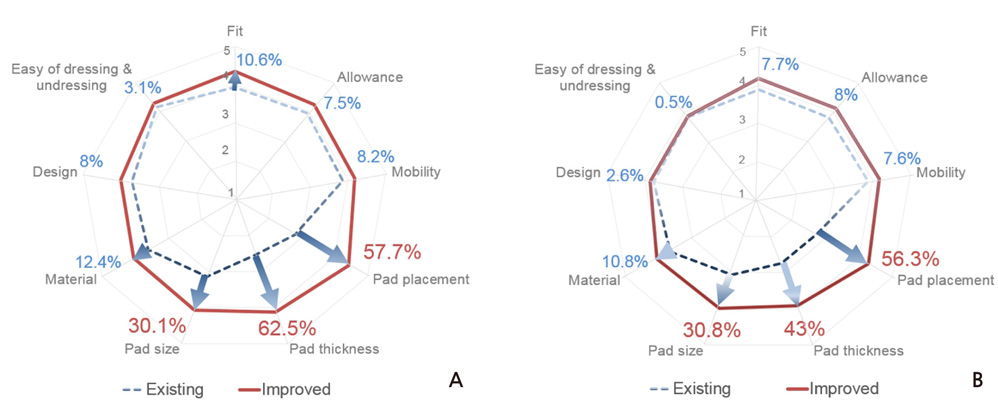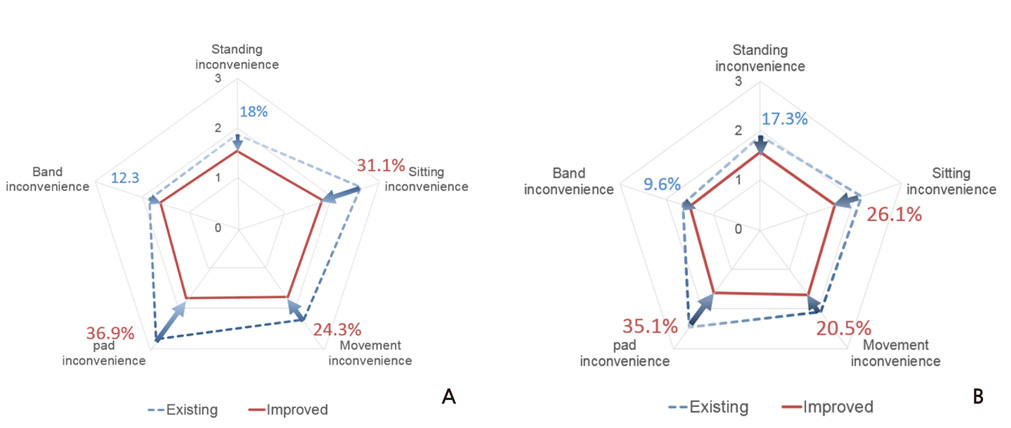J Korean Fract Soc.
2017 Oct;30(4):180-185. 10.12671/jkfs.2017.30.4.180.
Evaluation of the Wearing Characteristics of Hip Protectors Based on Draping Pattern Design and Body Shape in Korean Elderly People
- Affiliations
-
- 1Department of Industrial and Management Engineering, Pohang University of Science and Technology, Pohang, Korea.
- 2Department of Clothing and Textiles, College of Human Ecology, Kyungpook National University, Daegu, Korea. hekim@knu.ac.kr
- 3Department of Rehabilitation, Chonbuk National University Hospital, Jeonju, Korea.
- 4Department of Orthopedic Surgery, Chonbuk National University Hospital, Jeonju, Korea.
- KMID: 2424129
- DOI: http://doi.org/10.12671/jkfs.2017.30.4.180
Abstract
- PURPOSE
The purpose of this study was to verify the new hip protector design with respect to the comfort and mobility. The new hip protector was developed based on a pattern of draping and body shape of Korean elderly individuals.
MATERIALS AND METHODS
An wearing characteristics evaluation was conducted on 101 elderly women wearing hip protector using a questionnaire of preference and ease of wearing. Hip protectors, with existing and newly developed belt and underwear types, which were previously preferred by the Korean elderly, were evaluated.
RESULTS
The newly developed belt type (65.0%) and newly developed underwear type (30.1%) hip protectors were preferred to the existing type (3.9%) and existing underwear type (1.0%) ones. The convenience of the newly developed belt type was greater than 4 out of 5 points (1 for strongly disagree and 5 for strongly agree) for all nine measures, including fit, allowance, mobility, pad placement, pad thickness, pad size, material, design, ease of dressing, and ease of undressing. The newly developed hip protectors showed less discomfort than the existing ones. In particular, the newly developed belt type and developed underwear type improved sitting convenience by 31.1% and 26.1%, respectively, compared with the existing ones.
CONCLUSION
The hip protectors developed in the present study is expected to provide better fit for the body shape of Korean elderly individuals and prevent hip fracture due to fall.
Keyword
Figure
Reference
-
1. Kwon OY. Characteristics of fall incidence in an elderly community population and the effects of exercise training on strength and balance for elderly fallers [dissertation]. Daegu: Keimyung University;1997.2. Jeon EJ, Park SK, You HC, Kim HE. Wearing characteristic evaluation of hip protector for hip fracture prevention. Fash Text Res J. 2014; 16:1001–1007.
Article3. Compston J. The national osteoporosis guideline: comprehensive and up to date. Prescriber. 2008; 19:7–9.
Article4. Kannus P, Parkkari J, Niemi S, et al. Prevention of hip fracture in elderly people with use of a hip protector. N Engl J Med. 2000; 343:1506–1513.
Article5. Lauritzen JB, Petersen MM, Lund B. Effect of external hip protectors on hip fractures. Lancet. 1993; 341:11–13.
Article6. O'Halloran PD, Murray LJ, Cran GW, Dunlop L, Kernohan G, Beringer TR. The effect of type of hip protector and resident characteristics on adherence to use of hip protectors in nursing and residential homes: an exploratory study. Int J Nurs Stud. 2005; 42:387–397.7. Joo JH, Lee SC, Ahn HS, Park JS, Lee WJ, Jung KA. Evaluation of the alpha angle in asymptomatic adult hip joints: analysis of 994 hips. Hip Int. 2013; 23:395–399.
Article8. Jeon EJ, Park SK, You HC, Kim HE. Development of a sizing system and a draping pattern for hip protector based on 3D data analysis of Korean older women. Fash Text Res J. 2016; 18:120–129.
Article9. Cho JY, Jeong JR, Yeon SM, Chang JH, You HC, Kim HE. Cost-effectiveness analysis for clothing design improvement using ergonomic methods: evaluation of flame-proof clothing and design optimization. J Ergon Soc Korea. 2008; 27:45–58.
Article10. Yeow PHP, Sen RN. Quality, productivity, occupational health and safety and cost effectiveness of ergonomic improvements in the test workstations of an electronic factory. Int J Indust Ergon. 2003; 32:147–163.
Article11. Park HJ, Shin SC, Shon BH, Hong KH. Improvement of ECG measurement for the elderly's U-healthcare clothing using 3D tight-fit pattern. Fash Text Res J. 2008; 10:676–682.
- Full Text Links
- Actions
-
Cited
- CITED
-
- Close
- Share
- Similar articles
-
- Wearing Sensibility Related to Body Shape in Middle Aged Women
- Nested Case-control Study on the Association between Alcohol and the Risk of Proximal Hip Fracture in the Elderly People in Korea
- Body Mass Index and Body Shape
- Implant Design in Cementless Hip Arthroplasty
- The effect of xerostomia on perceived oral health among Hansen's people wearing dentures





